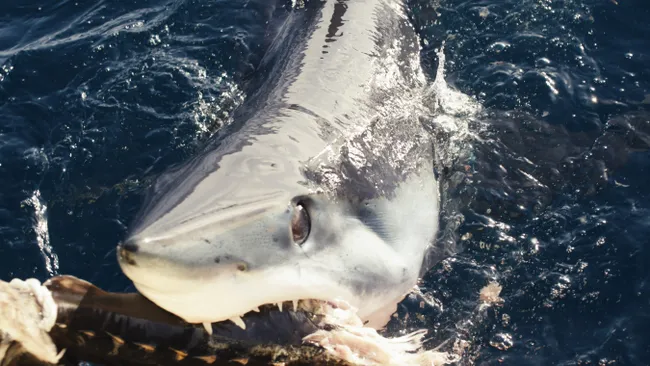Weird makos filmed off the California coast in a new Shark Week show raise questions about what these sharks actually are.
In 2019, shark tagger Keith Poe was working off the coast of California when he hooked an unusually large and dark-colored shark — a so-called “black mako.” The animal stood out not just for its size, but for its unusual dark coloring, which differed significantly from the typical dark blue or gray of shortfin makos (Isurus oxyrinchus) with their signature white undersides.
This encounter inspired the new Shark Week episode, Black Mako of the Abyss, in which a team of experts sets out to determine exactly what Poe encountered. Theories include genetic mutations, misidentification, or even the possibility of hybridization between the shortfin mako and another species.
Joining Poe in the investigation are environmental scientist Kendyl Berna, marine biologist Tristan Guttridge, and shark attack survivor Paul de Gelder. Together, they venture 40 miles (64 km) offshore in search of black makos. Their primary goal: to collect tissue samples for genetic analysis.
High-Tech Tactics
To attract these elusive sharks, the team uses a helicopter to drop hundreds of gallons of chum into the water. They later deploy a white shark decoy to test if any makos would engage with it. Eventually, a large, aggressive, and unusually dark mako appears — showing characteristics similar to those in Poe’s original footage.
This shark displayed both shortfin and longfin features, leading the team to speculate it could be a longfin mako (Isurus paucus), or perhaps even a hybrid.
A Rare and Elusive Species
Longfin makos are far less understood than their shortfin relatives. Typically found in deeper, more tropical waters, they are rarely seen off California. They also differ in appearance: slimmer bodies, longer pectoral fins, and darker coloration. To better distinguish between species, the team encourages sharks to breach the surface, giving them a clearer view of their fins and body shapes.
Though several shortfins were seen, one shark stood out with notably long pectoral fins, suggesting it might be a hybrid or simply a longfin in an unexpected region.
Could It Be a Hybrid?
Shark hybridization is rare but not unprecedented. In 2011, researchers in Australia documented hybrids between blacktip whaler shark species (Carcharhinus tilstoni and C. limbatus), and in 2019, scalloped and Carolina hammerheads (Sphyrna lewini and S. gilberti) were shown to hybridize in the western North Atlantic.
Still, experts caution against jumping to conclusions.
“Different species with naturally overlapping ranges typically don’t hybridize,” said Jess A.T. Morgan, a principal scientist at Queensland’s Department of Primary Industries and co-author of the 2011 blacktip hybrid study. “And even if they did, the offspring would likely be sterile.”
Morgan emphasized that only DNA testing can definitively determine if a shark is a hybrid. “Shark appearances can be deceptive,” she said. “Species in the same genus, especially juveniles, are often hard to tell apart visually.”
Environmental Changes Could Be a Factor

Berna noted another possibility: the dark-colored makos are simply longfins appearing closer to the coast, potentially driven by climate change, overfishing, or shifting prey availability.
“I think it’s possible these black makos are actually just longfin makos,” Berna said. “When you see a mako in waters it’s not typically found in, looking unusual, it’s easy to assume it’s a shortfin anomaly — but it could just be a longfin extending its range.”
Longfins are generally known to inhabit tropical waters, including those off Mexico, but rising ocean temperatures could be pushing them northward, she added.
Douglas Adams, a researcher at the Florida Fish & Wildlife Conservation Commission, echoed that sentiment.
“Many questions remain regarding the range and habitat use of longfin makos,” he said, adding that warming oceans have already caused range shifts in many fish species.
The Search Continues
Despite close encounters, the team was unable to collect a tissue sample, as the sharks moved too quickly. Still, they remain determined.
“A genetic sample would be the absolute, highest form of confirmation we could get,” said Berna. “That, ultimately, is the goal.”
Until then, the mystery of the black mako remains unsolved — an enigma that blends science, speculation, and the evolving nature of life in our oceans.
